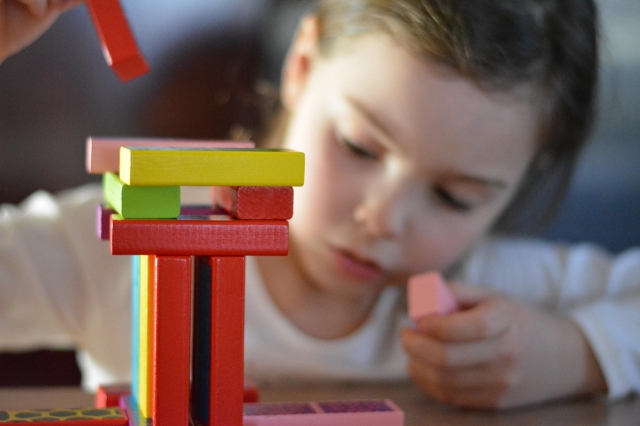Play-based learning is an educational approach where children gain knowledge and develop skills through engaging in meaningful play activities. It emphasises the use of creativity, exploration, and problem-solving, allowing children to interact with their surroundings in an open-ended way.
It also supports cognitive development, helping them think critically and solve problems independently. It nurtures social skills as children engage in cooperative play and enhances emotional well-being by creating a sense of joy and accomplishment as well. Finally, it allows children to develop foundational skills for their future academic and personal growth.
Below are practical ways to integrate play-based learning into daily routines, helping young children learn in a natural and engaging manner.
Provide a Variety of Toys and Materials
Children benefit from access to diverse toys and materials that spark their curiosity. Items like building blocks, art supplies, or puzzles encourage creative exploration. Parents and educators can also explore toys online to find options tailored to different developmental stages. Choosing toys that inspire imagination ensures children stay engaged while learning.
This variety helps children improve fine motor skills, problem-solving abilities, and spatial awareness. Play involving art supplies fosters self-expression, while building blocks teach balance and patience. The availability of options lets children pick activities that align with their interests, making learning more enjoyable.
Some parents may worry about costs or storage space for these items. Opting for multipurpose toys or joining community toy-sharing programmes can address these concerns. Rotating toys periodically also helps maintain interest without overwhelming children with too many choices.
Encourage Role-Playing Activities
Role-playing activities, such as pretending to run a shop or taking care of dolls, enable children to explore real-world scenarios in a playful setting. This kind of play encourages creativity and helps them understand social roles and responsibilities. Providing costumes, props, or themed setups can further enrich the experience.
Through role-play, children learn empathy by imagining themselves in someone else's position. It also helps improve language skills as they mimic conversations and express ideas. Engaging in role-playing can build confidence as children practise scenarios they may encounter in real life.
A potential challenge might be limited resources for setting up these activities. Parents can use everyday household items like cardboard boxes or old clothes to create props. Joining local playgroups can also provide opportunities for collaborative role-playing.
Incorporate Outdoor Play
Outdoor play is an excellent way to encourage physical activity and connect children with nature. Activities like digging in sand, exploring gardens, or climbing playground equipment are examples of how children can learn through outdoor exploration. Unstructured outdoor time allows children to direct their own learning while staying active.
Playing outside strengthens muscles and coordination, supports overall health, and improves mood. It also fosters environmental awareness as children observe plants, animals, and weather patterns. Outdoor activities can inspire curiosity about science and the natural world.
Weather or lack of safe spaces might pose barriers to outdoor play. Visiting local parks or creating a small play area in a backyard can provide alternatives. For rainy days, indoor versions of outdoor games, such as obstacle courses, can keep children active and engaged.
Support Problem-Solving Games and Activities
Problem-solving games and activities like puzzles or treasure hunts teach critical thinking and patience. These activities encourage children to analyse situations, test solutions, and persist through challenges. Incorporating storytelling or themes can make problem-solving activities even more captivating.
Children who regularly engage in these games develop resilience and logical thinking skills. They also learn to approach tasks systematically and stay motivated, even when faced with difficulties. Such skills are valuable for academic success and everyday life.
Some children may initially struggle with problem-solving tasks. Offering guidance without providing direct answers can help them develop confidence. Celebrating their efforts, even if they don't succeed immediately, reinforces the value of persistence and learning through trial and error.
Include Music and Movement
Music and movement activities, such as singing, dancing, or playing simple instruments, are engaging ways to combine learning and fun. These activities help children develop rhythm, coordination, and memory skills. Singing songs with educational content, like counting or alphabet tunes, can add an extra layer of learning.
The benefits of music and movement go beyond physical development. These activities support emotional regulation, enhance focus, and boost self-esteem. Children also build social connections through group activities, such as dancing or singing in a circle.
Parents or educators might worry about needing specialised tools or instruments. Everyday items, like pots and wooden spoons, can double as percussion instruments. Many free online resources also offer guided music and movement sessions, making these activities accessible to all.
Final Thoughts
Play-based learning provides a natural and enjoyable way for young children to explore the world around them. It offers significant cognitive, social, and emotional benefits, helping children build essential skills for the future. While this guide provides practical suggestions, parents and educators with specific concerns should seek professional advice for personalised guidance.






